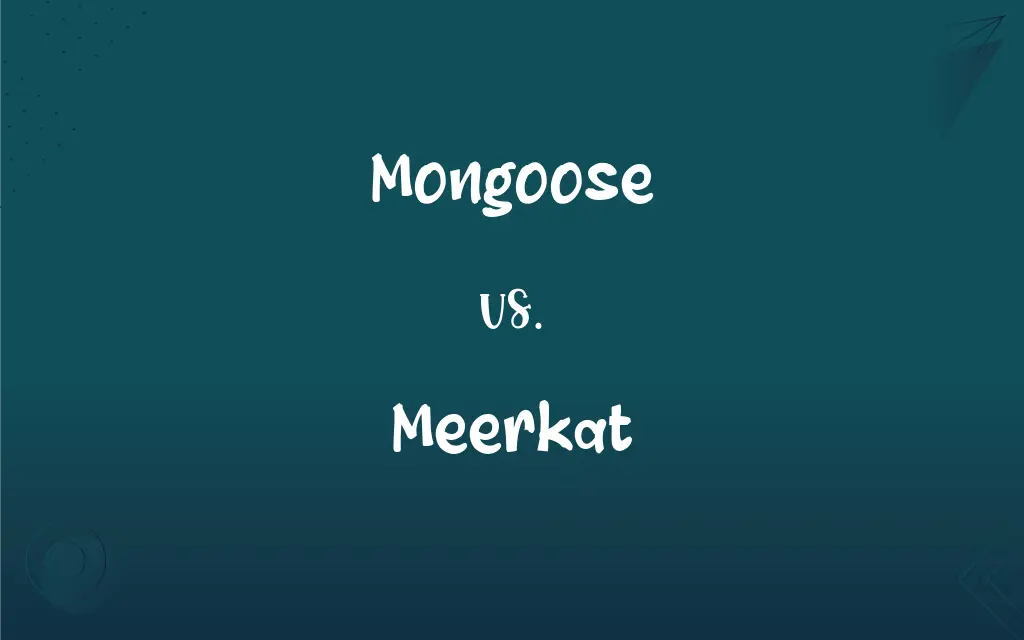Mongoose vs. Meerkat: What's the Difference?
Edited by Aimie Carlson || By Janet White || Updated on October 12, 2023
A mongoose is a carnivorous mammal known for hunting snakes, while a meerkat is a small carnivorous mammal that belongs to the mongoose family and is known for its social behavior.

Key Differences
Mongoose and meerkat, both captivating creatures, vary in several aspects. A mongoose is a term used to describe around 34 species of small carnivores found primarily in Africa but also in parts of Asia and southern Europe. Renowned for their snake-fighting abilities, mongooses are agile and have a varied diet that includes insects, crabs, earthworms, and even birds and rodents. Contrarily, meerkats are specific members of the mongoose family and are native exclusively to the southern parts of Africa.
Diving deeper into appearance, mongooses come in various sizes and colors, from gray to brown, and might even have stripes or spots. They can be as small as a squirrel or almost as large as a housecat, depending on the species. On the other side, meerkats have a slender, pointed face, and their fur is peppered with gray, brown, and tan patterns which serve as a camouflage. Standing with a distinct, upright posture on their hind legs, meerkats often use their tail for balance.
Habitat and behavior provide another point of distinction. Mongooses live in a range of habitats, from forests to grasslands and even semi-arid areas. Some species are solitary, while others might live in groups. Meerkats, however, are specifically adapted to the arid savannahs and are known for their complex social structures, living in large underground networks with multiple entrances. They function in groups, or "clans," and exhibit sentinel behavior, where one meerkat stands guard while others forage.
In terms of diet, while both mongoose and meerkats are carnivorous, their preferences can differ. Mongooses eat a wider range of food, including reptiles, and are particularly known for their ability to combat venomous snakes. Meerkats primarily eat insects but will also consume lizards, birds, and fruits. Their long, curved claws are perfect for digging up insect larvae and other burrowed prey.
Comparison Chart
Family
Herpestidae
Herpestidae (specifically a member of this family)
ADVERTISEMENT
Distribution
Africa, Asia, and southern Europe
Southern parts of Africa
Physical Appearance
Varies in size and color
Slender face with gray, brown, and tan patterns
Social Behavior
Varies (some solitary, some in groups)
Highly social, live in clans
Diet
Insects, crabs, reptiles, rodents, birds
Mainly insects, but also lizards, birds, and fruits
Mongoose and Meerkat Definitions
Mongoose
A small predator known for its agility.
The village revered the mongoose for keeping venomous snakes at bay.
ADVERTISEMENT
Meerkat
A small carnivorous mammal native to Africa.
The meerkat stood upright, scanning its surroundings.
Mongoose
A mammal belonging to the family Herpestidae.
Several species of mongoose can be found in Asia.
Meerkat
A member of the mongoose family with distinct social behaviors.
Tourists enjoyed watching the meerkat clans interact.
Mongoose
An animal with a varied diet, including snakes and insects.
Observers marveled at the mongoose's versatility in hunting.
Meerkat
An animal with a slender, pointed face and upright posture.
The meerkat's fur pattern helped camouflage it in the desert.
Mongoose
A carnivorous mammal with a long body and tail.
The mongoose swiftly attacked the snake.
Meerkat
A creature known for living in underground networks.
The meerkat burrows had multiple entrances for safety.
Mongoose
Any of various carnivorous mammals of the family Herpestidae, native to Asia, Africa, and southern Europe and introduced elsewhere, having a slender agile body and a long tail, and noted for the ability to seize and kill venomous snakes.
Meerkat
A mammal recognized for its sentinel behavior.
One meerkat stood guard while the rest of the clan foraged for food.
Mongoose
Any of several species of generalist predatory Carnivores in the family Herpestidae; the various species range in size from rats to large cats. The Indian mongoose is noted as a predator of venomous snakes, though other mongoose species have similar habits.
Meerkat
A small burrowing mongoose (Suricata suricatta) of southern Africa, having brownish-gray fur and a long tail, which it uses for balance when it stands on its hind legs. Also called suricate.
Mongoose
Any species of pl=s; only distantly related to the Herpestidae, these are members of the family Eupleridae; they resemble mongooses in appearance and habits, but have larger ears and ringed tails.
Meerkat
Suricata suricatta, a small carnivorous mammal of the mongoose family, from the Kalahari Desert, known for its habit of standing on its hind legs.
Mongoose
A species of ichneumon (Herpestes griseus), native of India. Applied also to other allied species, as the African banded mongoose (Crossarchus fasciatus).
Meerkat
A South African carnivore (Suricata suricata, formerly Cynictis penicillata), allied to the ichneumons, having a lemurlike face and only four toes; called also yellow mongoose and suricate.
While his compatrioits scuffle about in the sand for delicious scorpions or fat, tasty mice, one meerkat stands alone, bolt upright on an exposed perch, scanning for hawks with dark eyes wide, ready to call out at the first sign of danger. Like other such guards in the animal kingdom, these endearingly vulnerable meerkat sentinels have long impressed biologists as true altruists - creatures willing to forgo food and brave danger to protect others. Now a study in the current Science suggests that these beasts may not be such adorable heroes after all. Researchers have discovered that meerkats abandon their hunting to act as guards only when their bellies are good and full. And they appear to do so, not as an act of noble daring, but because by being the first to see a predator, they can be sure of being the first down a hole and out of harm's way. Standing guard, researchers concluded, may be the safest thing to do once a meerkat has had enough to eat. . . . Even the adorable meerkat may yet redeem itself as a bit of an altruist. Although being a sentinel may itself not entail great risk, it is hard to imagine a selfish reason for their giving a shout of warning before dashing for cover. . . .
Mongoose
A Madagascan lemur (Lemur mongos).
Meerkat
A mongoose-like viverrine of South Africa having a face like a lemur and only four toes
Mongoose
Agile grizzled Old World viverrine; preys on snakes and rodents
Mongoose
A creature found in diverse habitats from forests to grasslands.
The mongoose adapted well to the new grassland environment.
FAQs
How do meerkats communicate with each other?
Meerkats use vocalizations, body language, and scent markings.
Are all mongooses immune to snake venom?
Not all, but some mongoose species have resistance to certain snake venoms.
What is the primary habitat of meerkats?
Meerkats are native to the arid savannahs of southern Africa.
How do mongooses defend themselves?
They use their agility, sharp teeth, and in some cases, resistance to venom.
How long do meerkats live?
In the wild, meerkats live up to 10 years.
Where can mongooses be found?
Mongooses are mainly found in Africa, parts of Asia, and southern Europe.
Are mongooses aggressive?
They can be, especially when threatened or cornered.
Why do meerkats stand on their hind legs?
To get a better view of their surroundings and look out for predators.
Do meerkats have a specific social structure?
Yes, they live in clans with complex social hierarchies.
What do mongooses eat?
Their diet includes insects, reptiles, birds, and even rodents.
Can mongooses be domesticated?
Generally no, they are wild animals with specific needs.
What's the gestation period for a mongoose?
It varies but is typically around 60 days.
Are meerkats carnivorous?
Yes, but they mainly eat insects and occasionally lizards, birds, and fruits.
How big can a mongoose get?
It varies by species, from the size of a squirrel to almost as large as a housecat.
Do meerkats have predators?
Yes, they are preyed upon by birds of prey, snakes, and jackals.
How many meerkats typically live in a clan?
A clan can consist of anywhere from a couple to over 30 meerkats.
How do mongooses interact with humans?
In some areas, they're seen as beneficial for pest control, but they can also transmit diseases.
Are meerkats endangered?
No, but habitat destruction poses threats to their populations.
About Author
Written by
Janet WhiteJanet White has been an esteemed writer and blogger for Difference Wiki. Holding a Master's degree in Science and Medical Journalism from the prestigious Boston University, she has consistently demonstrated her expertise and passion for her field. When she's not immersed in her work, Janet relishes her time exercising, delving into a good book, and cherishing moments with friends and family.
Edited by
Aimie CarlsonAimie Carlson, holding a master's degree in English literature, is a fervent English language enthusiast. She lends her writing talents to Difference Wiki, a prominent website that specializes in comparisons, offering readers insightful analyses that both captivate and inform.































































